FINA6000: Managing Finance - Australian IPO Case Analysis
VerifiedAdded on 2022/10/02
|12
|2704
|171
Report
AI Summary
This report presents a case analysis of two Australian Securities Exchange (ASX) listed companies, Caeneus Minerals Limited and Calima Energy Limited, focusing on their initial public offerings (IPOs). The analysis evaluates the companies' share price performance post-IPO, examining the factors influencing price movements, including underpricing strategies and overall financial performance. The report addresses key questions related to IPOs, such as the impact of going public on financial performance, the significance of underpricing, and the companies' dividend policies and working capital management. It explores the reasons behind fluctuations in share prices, the effectiveness of investment strategies, and the long-term implications of IPOs on business growth and shareholder value. The study highlights the contrasting experiences of the two companies, providing insights into the complexities of IPOs and their effects on corporate financial outcomes.
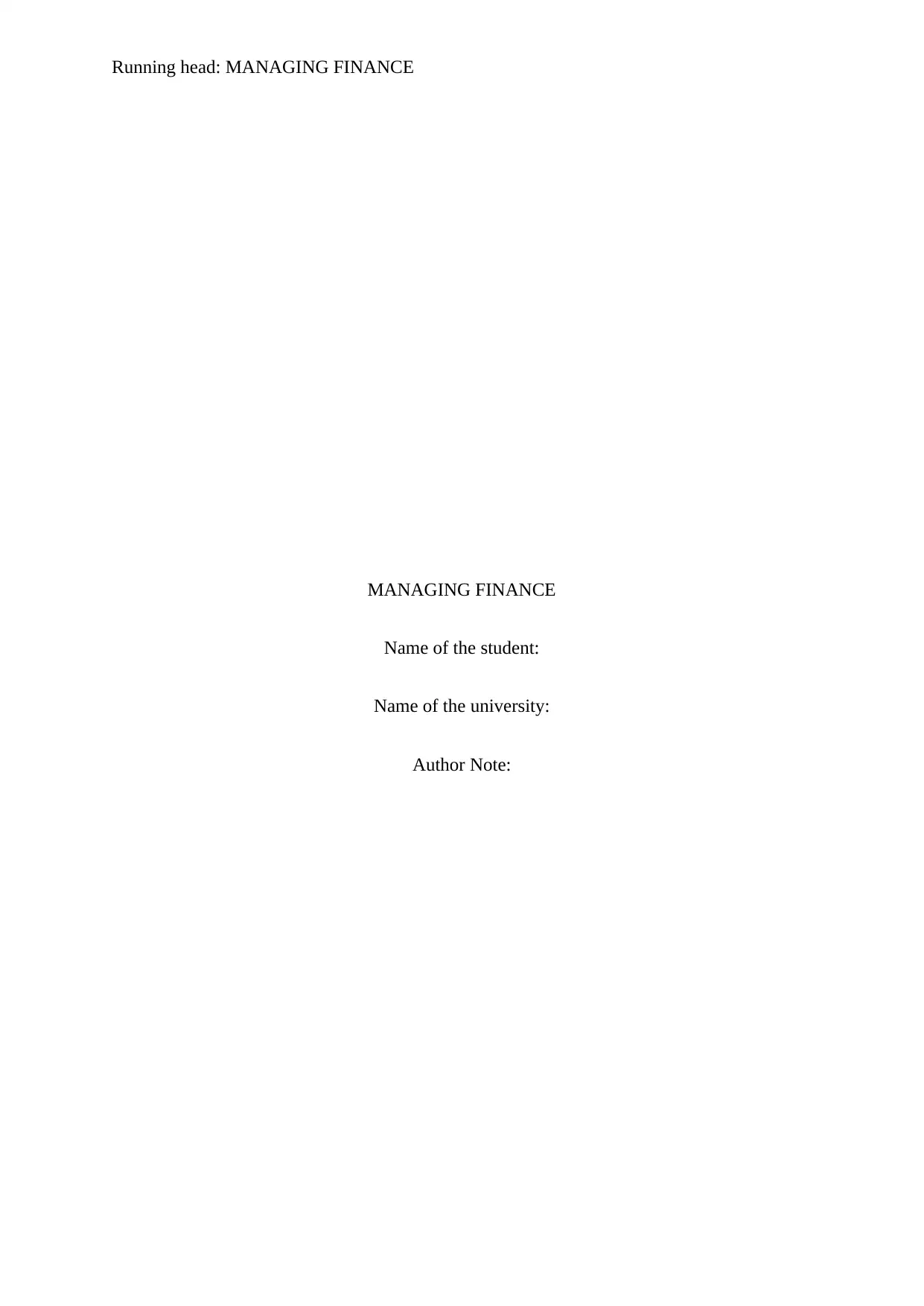
Running head: MANAGING FINANCE
MANAGING FINANCE
Name of the student:
Name of the university:
Author Note:
MANAGING FINANCE
Name of the student:
Name of the university:
Author Note:
Paraphrase This Document
Need a fresh take? Get an instant paraphrase of this document with our AI Paraphraser
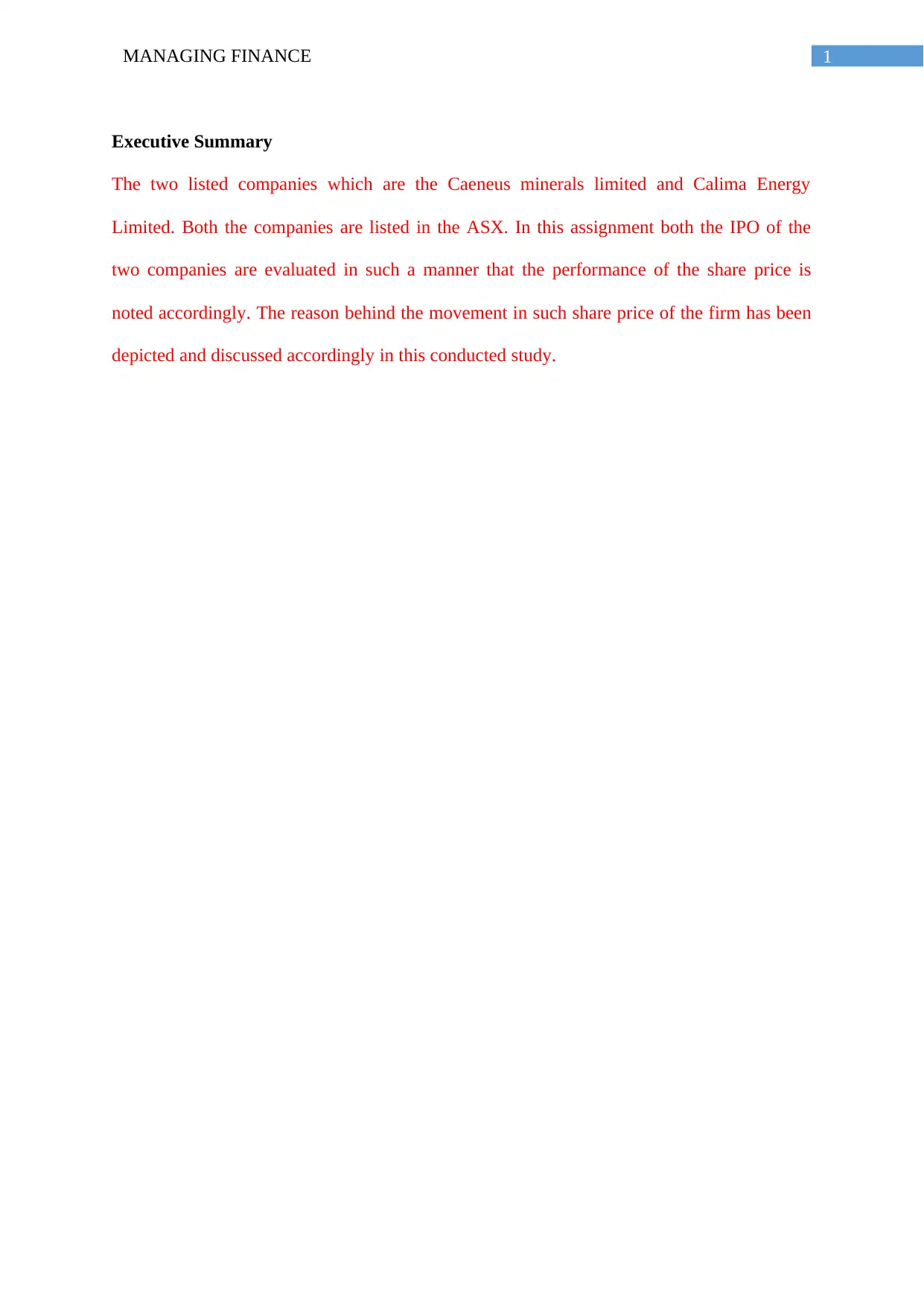
1MANAGING FINANCE
Executive Summary
The two listed companies which are the Caeneus minerals limited and Calima Energy
Limited. Both the companies are listed in the ASX. In this assignment both the IPO of the
two companies are evaluated in such a manner that the performance of the share price is
noted accordingly. The reason behind the movement in such share price of the firm has been
depicted and discussed accordingly in this conducted study.
Executive Summary
The two listed companies which are the Caeneus minerals limited and Calima Energy
Limited. Both the companies are listed in the ASX. In this assignment both the IPO of the
two companies are evaluated in such a manner that the performance of the share price is
noted accordingly. The reason behind the movement in such share price of the firm has been
depicted and discussed accordingly in this conducted study.
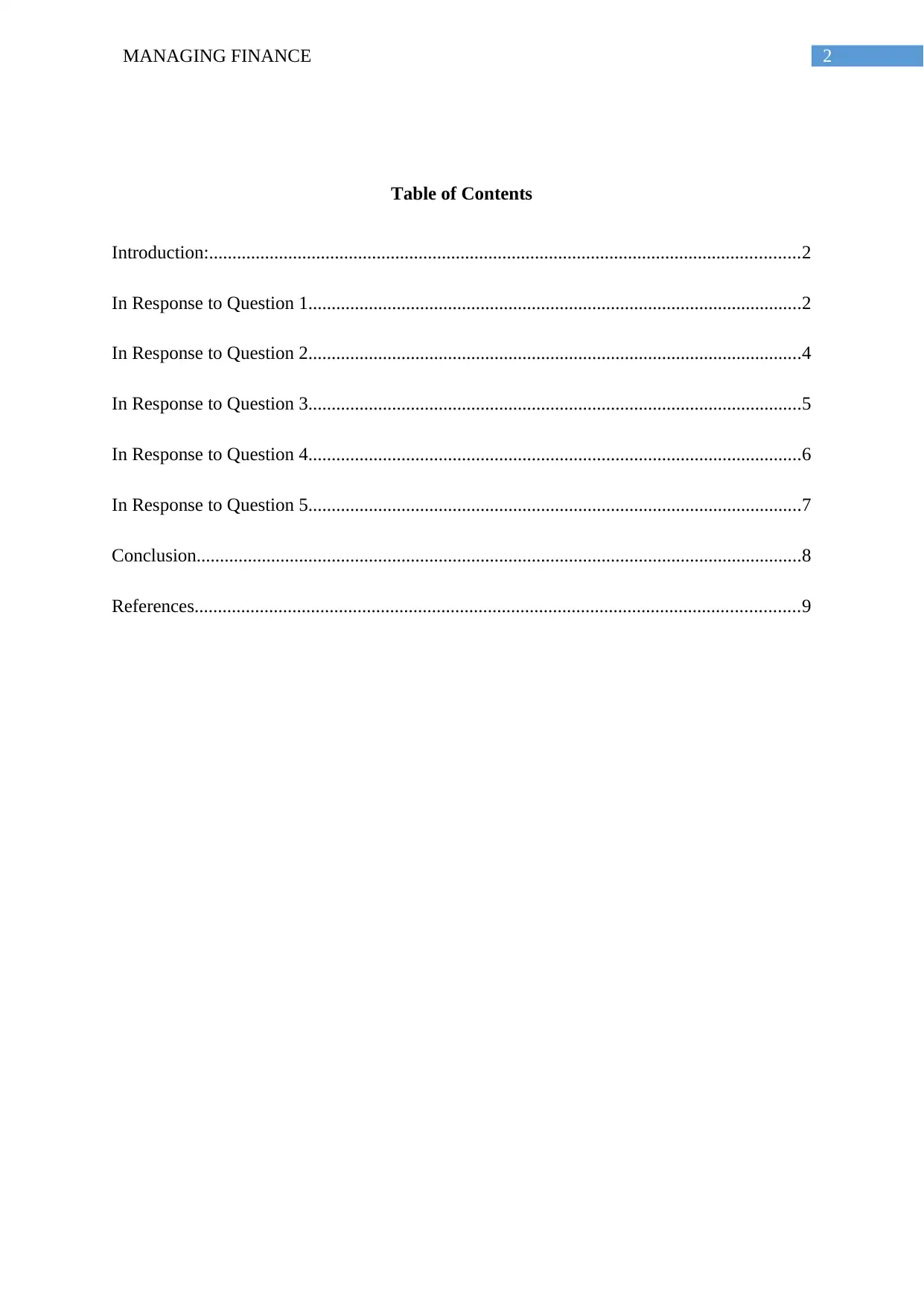
2MANAGING FINANCE
Table of Contents
Introduction:...............................................................................................................................2
In Response to Question 1..........................................................................................................2
In Response to Question 2..........................................................................................................4
In Response to Question 3..........................................................................................................5
In Response to Question 4..........................................................................................................6
In Response to Question 5..........................................................................................................7
Conclusion..................................................................................................................................8
References..................................................................................................................................9
Table of Contents
Introduction:...............................................................................................................................2
In Response to Question 1..........................................................................................................2
In Response to Question 2..........................................................................................................4
In Response to Question 3..........................................................................................................5
In Response to Question 4..........................................................................................................6
In Response to Question 5..........................................................................................................7
Conclusion..................................................................................................................................8
References..................................................................................................................................9
⊘ This is a preview!⊘
Do you want full access?
Subscribe today to unlock all pages.

Trusted by 1+ million students worldwide
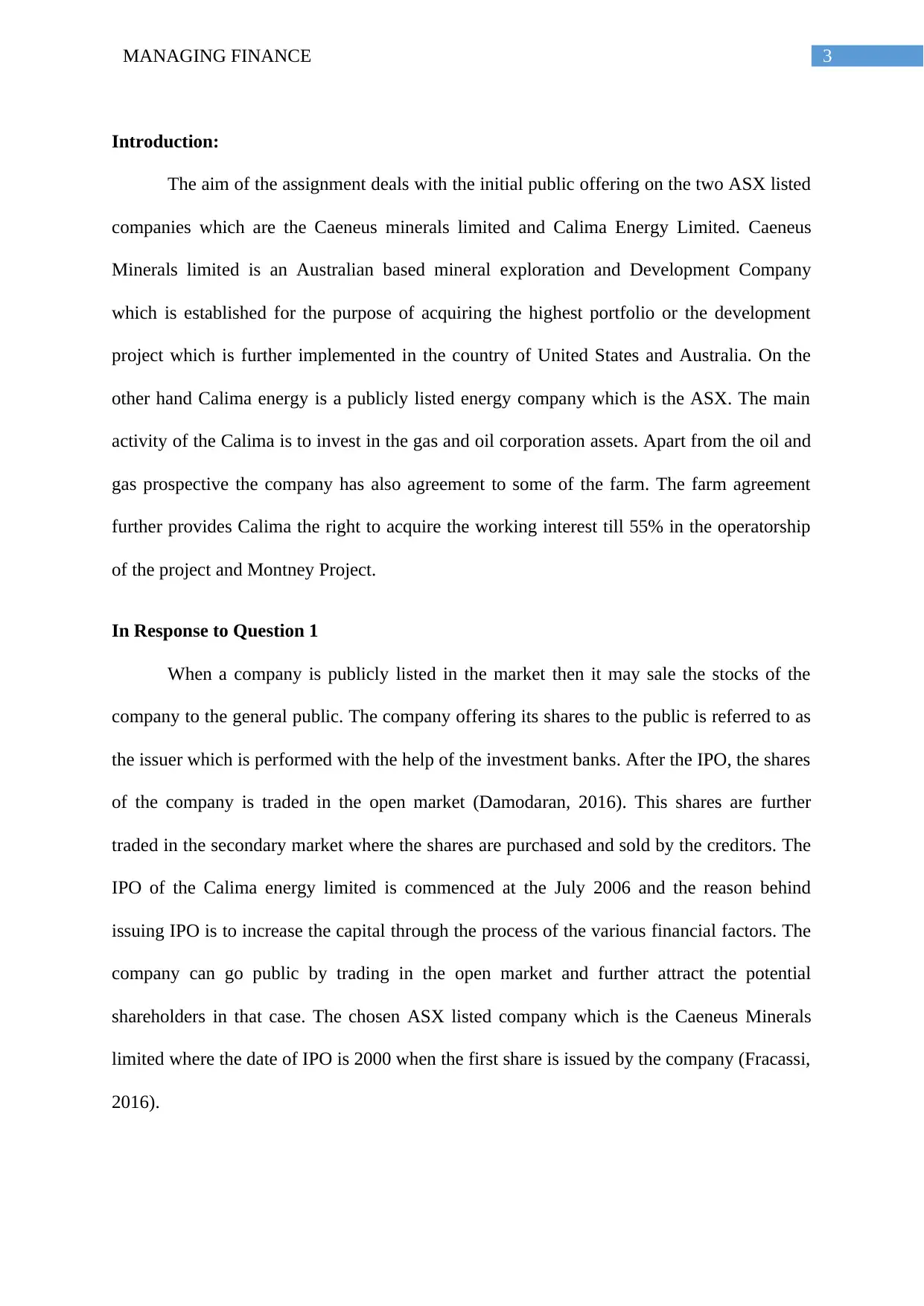
3MANAGING FINANCE
Introduction:
The aim of the assignment deals with the initial public offering on the two ASX listed
companies which are the Caeneus minerals limited and Calima Energy Limited. Caeneus
Minerals limited is an Australian based mineral exploration and Development Company
which is established for the purpose of acquiring the highest portfolio or the development
project which is further implemented in the country of United States and Australia. On the
other hand Calima energy is a publicly listed energy company which is the ASX. The main
activity of the Calima is to invest in the gas and oil corporation assets. Apart from the oil and
gas prospective the company has also agreement to some of the farm. The farm agreement
further provides Calima the right to acquire the working interest till 55% in the operatorship
of the project and Montney Project.
In Response to Question 1
When a company is publicly listed in the market then it may sale the stocks of the
company to the general public. The company offering its shares to the public is referred to as
the issuer which is performed with the help of the investment banks. After the IPO, the shares
of the company is traded in the open market (Damodaran, 2016). This shares are further
traded in the secondary market where the shares are purchased and sold by the creditors. The
IPO of the Calima energy limited is commenced at the July 2006 and the reason behind
issuing IPO is to increase the capital through the process of the various financial factors. The
company can go public by trading in the open market and further attract the potential
shareholders in that case. The chosen ASX listed company which is the Caeneus Minerals
limited where the date of IPO is 2000 when the first share is issued by the company (Fracassi,
2016).
Introduction:
The aim of the assignment deals with the initial public offering on the two ASX listed
companies which are the Caeneus minerals limited and Calima Energy Limited. Caeneus
Minerals limited is an Australian based mineral exploration and Development Company
which is established for the purpose of acquiring the highest portfolio or the development
project which is further implemented in the country of United States and Australia. On the
other hand Calima energy is a publicly listed energy company which is the ASX. The main
activity of the Calima is to invest in the gas and oil corporation assets. Apart from the oil and
gas prospective the company has also agreement to some of the farm. The farm agreement
further provides Calima the right to acquire the working interest till 55% in the operatorship
of the project and Montney Project.
In Response to Question 1
When a company is publicly listed in the market then it may sale the stocks of the
company to the general public. The company offering its shares to the public is referred to as
the issuer which is performed with the help of the investment banks. After the IPO, the shares
of the company is traded in the open market (Damodaran, 2016). This shares are further
traded in the secondary market where the shares are purchased and sold by the creditors. The
IPO of the Calima energy limited is commenced at the July 2006 and the reason behind
issuing IPO is to increase the capital through the process of the various financial factors. The
company can go public by trading in the open market and further attract the potential
shareholders in that case. The chosen ASX listed company which is the Caeneus Minerals
limited where the date of IPO is 2000 when the first share is issued by the company (Fracassi,
2016).
Paraphrase This Document
Need a fresh take? Get an instant paraphrase of this document with our AI Paraphraser
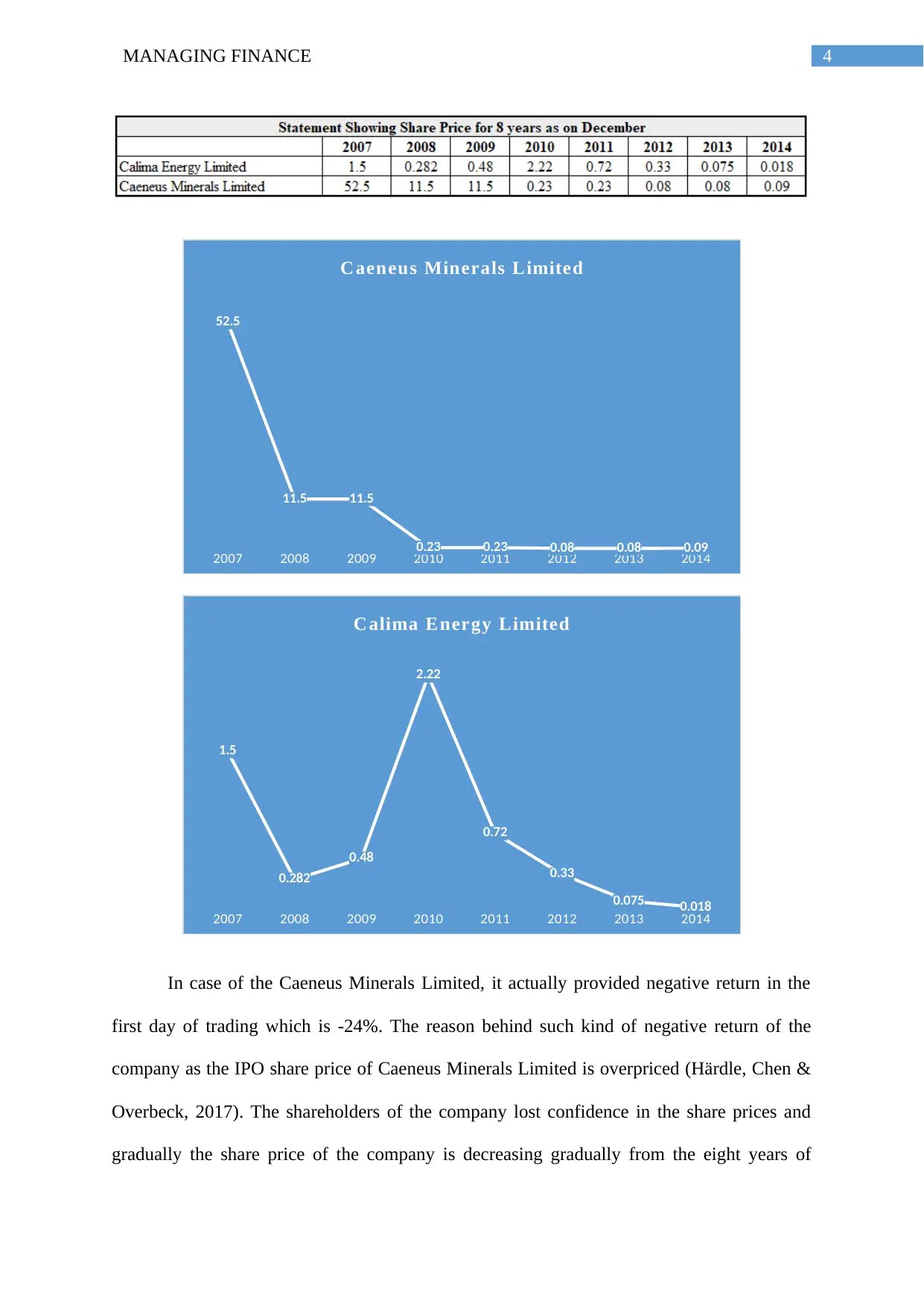
4MANAGING FINANCE
2007 2008 2009 2010 2011 2012 2013 2014
1.5
0.282
0.48
2.22
0.72
0.33
0.075 0.018
C alima Energy Limited
In case of the Caeneus Minerals Limited, it actually provided negative return in the
first day of trading which is -24%. The reason behind such kind of negative return of the
company as the IPO share price of Caeneus Minerals Limited is overpriced (Härdle, Chen &
Overbeck, 2017). The shareholders of the company lost confidence in the share prices and
gradually the share price of the company is decreasing gradually from the eight years of
2007 2008 2009 2010 2011 2012 2013 2014
52.5
11.5 11.5
0.23 0.23 0.08 0.08 0.09
C aeneus Minerals Limited
2007 2008 2009 2010 2011 2012 2013 2014
1.5
0.282
0.48
2.22
0.72
0.33
0.075 0.018
C alima Energy Limited
In case of the Caeneus Minerals Limited, it actually provided negative return in the
first day of trading which is -24%. The reason behind such kind of negative return of the
company as the IPO share price of Caeneus Minerals Limited is overpriced (Härdle, Chen &
Overbeck, 2017). The shareholders of the company lost confidence in the share prices and
gradually the share price of the company is decreasing gradually from the eight years of
2007 2008 2009 2010 2011 2012 2013 2014
52.5
11.5 11.5
0.23 0.23 0.08 0.08 0.09
C aeneus Minerals Limited
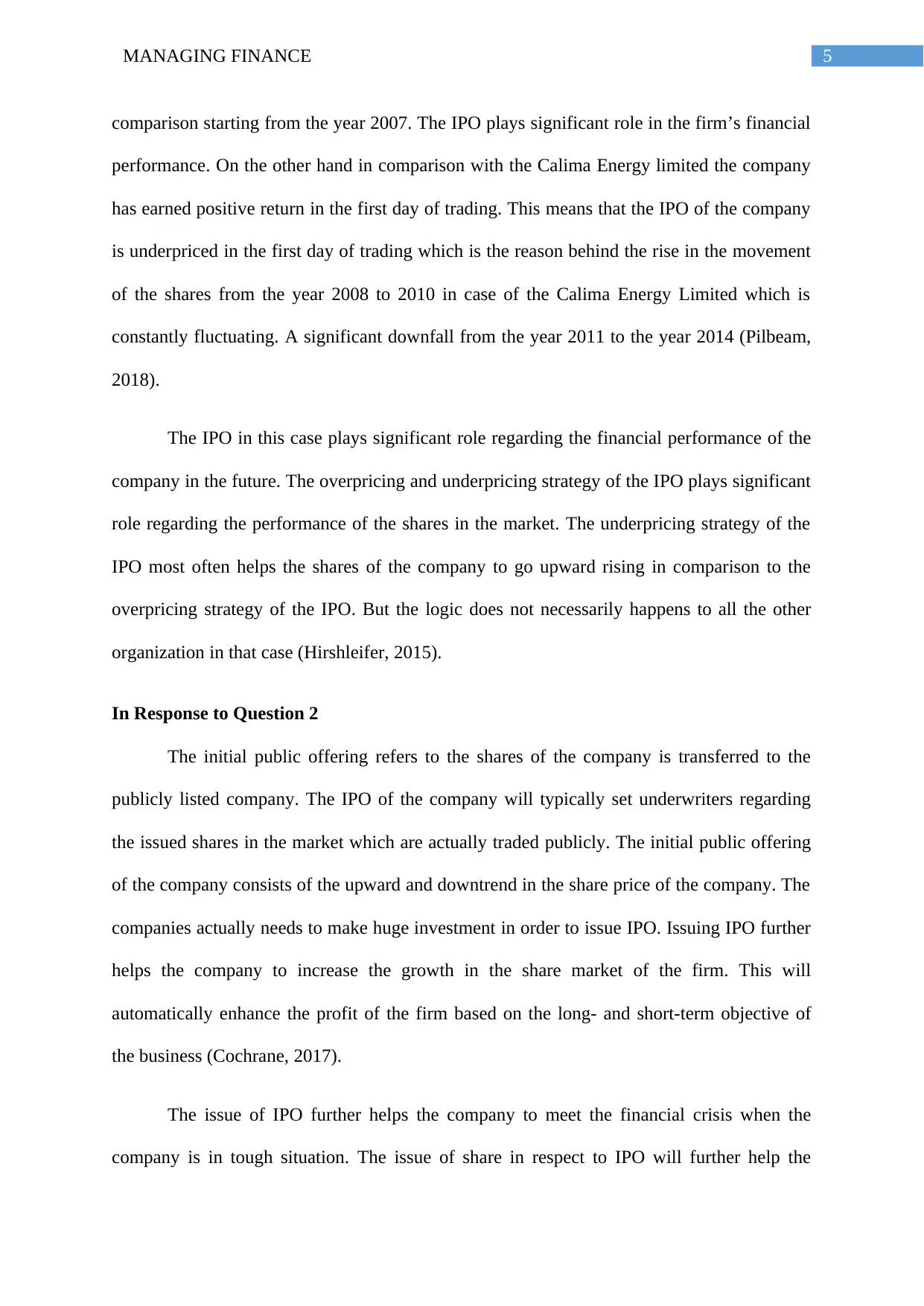
5MANAGING FINANCE
comparison starting from the year 2007. The IPO plays significant role in the firm’s financial
performance. On the other hand in comparison with the Calima Energy limited the company
has earned positive return in the first day of trading. This means that the IPO of the company
is underpriced in the first day of trading which is the reason behind the rise in the movement
of the shares from the year 2008 to 2010 in case of the Calima Energy Limited which is
constantly fluctuating. A significant downfall from the year 2011 to the year 2014 (Pilbeam,
2018).
The IPO in this case plays significant role regarding the financial performance of the
company in the future. The overpricing and underpricing strategy of the IPO plays significant
role regarding the performance of the shares in the market. The underpricing strategy of the
IPO most often helps the shares of the company to go upward rising in comparison to the
overpricing strategy of the IPO. But the logic does not necessarily happens to all the other
organization in that case (Hirshleifer, 2015).
In Response to Question 2
The initial public offering refers to the shares of the company is transferred to the
publicly listed company. The IPO of the company will typically set underwriters regarding
the issued shares in the market which are actually traded publicly. The initial public offering
of the company consists of the upward and downtrend in the share price of the company. The
companies actually needs to make huge investment in order to issue IPO. Issuing IPO further
helps the company to increase the growth in the share market of the firm. This will
automatically enhance the profit of the firm based on the long- and short-term objective of
the business (Cochrane, 2017).
The issue of IPO further helps the company to meet the financial crisis when the
company is in tough situation. The issue of share in respect to IPO will further help the
comparison starting from the year 2007. The IPO plays significant role in the firm’s financial
performance. On the other hand in comparison with the Calima Energy limited the company
has earned positive return in the first day of trading. This means that the IPO of the company
is underpriced in the first day of trading which is the reason behind the rise in the movement
of the shares from the year 2008 to 2010 in case of the Calima Energy Limited which is
constantly fluctuating. A significant downfall from the year 2011 to the year 2014 (Pilbeam,
2018).
The IPO in this case plays significant role regarding the financial performance of the
company in the future. The overpricing and underpricing strategy of the IPO plays significant
role regarding the performance of the shares in the market. The underpricing strategy of the
IPO most often helps the shares of the company to go upward rising in comparison to the
overpricing strategy of the IPO. But the logic does not necessarily happens to all the other
organization in that case (Hirshleifer, 2015).
In Response to Question 2
The initial public offering refers to the shares of the company is transferred to the
publicly listed company. The IPO of the company will typically set underwriters regarding
the issued shares in the market which are actually traded publicly. The initial public offering
of the company consists of the upward and downtrend in the share price of the company. The
companies actually needs to make huge investment in order to issue IPO. Issuing IPO further
helps the company to increase the growth in the share market of the firm. This will
automatically enhance the profit of the firm based on the long- and short-term objective of
the business (Cochrane, 2017).
The issue of IPO further helps the company to meet the financial crisis when the
company is in tough situation. The issue of share in respect to IPO will further help the
⊘ This is a preview!⊘
Do you want full access?
Subscribe today to unlock all pages.

Trusted by 1+ million students worldwide
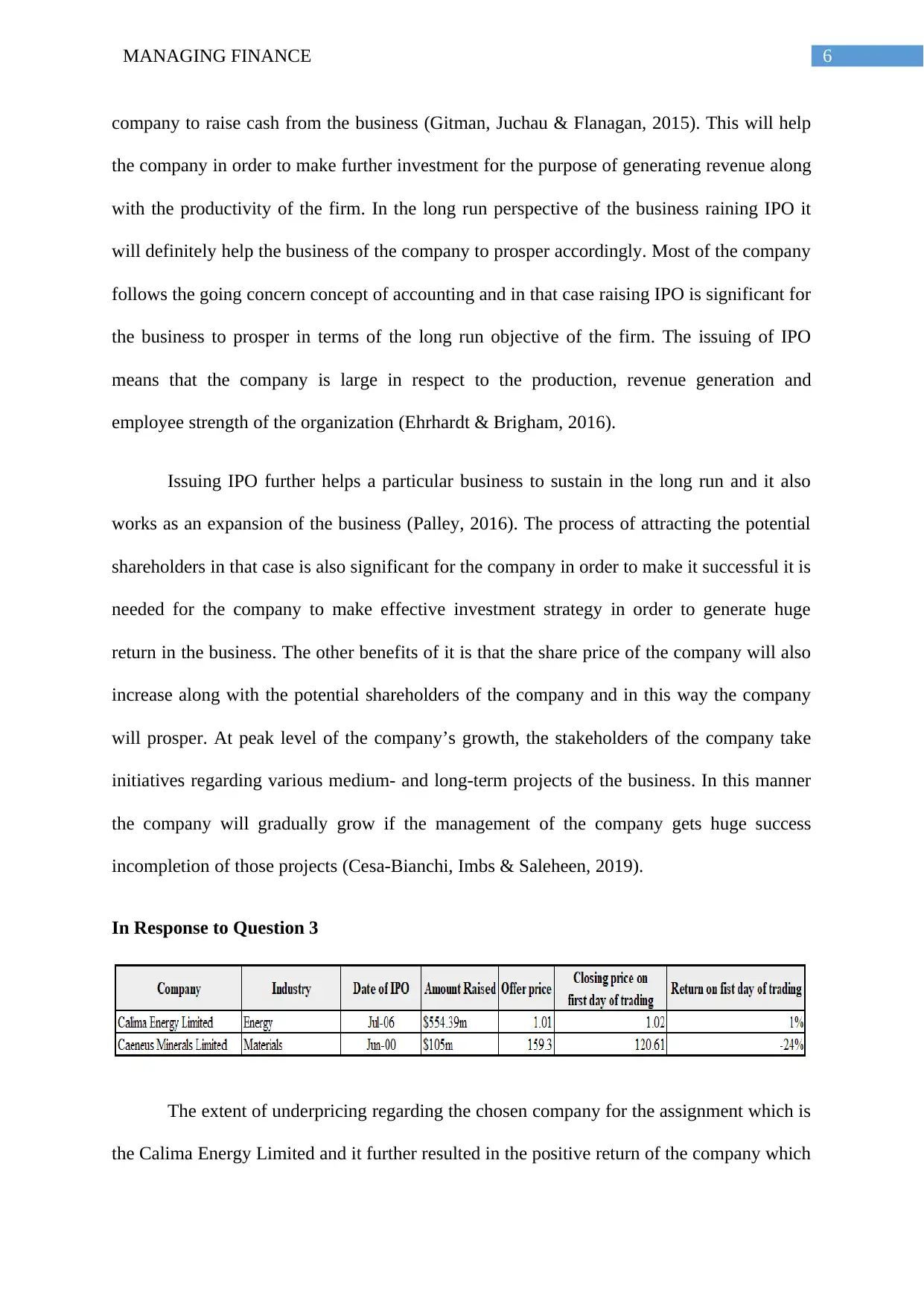
6MANAGING FINANCE
company to raise cash from the business (Gitman, Juchau & Flanagan, 2015). This will help
the company in order to make further investment for the purpose of generating revenue along
with the productivity of the firm. In the long run perspective of the business raining IPO it
will definitely help the business of the company to prosper accordingly. Most of the company
follows the going concern concept of accounting and in that case raising IPO is significant for
the business to prosper in terms of the long run objective of the firm. The issuing of IPO
means that the company is large in respect to the production, revenue generation and
employee strength of the organization (Ehrhardt & Brigham, 2016).
Issuing IPO further helps a particular business to sustain in the long run and it also
works as an expansion of the business (Palley, 2016). The process of attracting the potential
shareholders in that case is also significant for the company in order to make it successful it is
needed for the company to make effective investment strategy in order to generate huge
return in the business. The other benefits of it is that the share price of the company will also
increase along with the potential shareholders of the company and in this way the company
will prosper. At peak level of the company’s growth, the stakeholders of the company take
initiatives regarding various medium- and long-term projects of the business. In this manner
the company will gradually grow if the management of the company gets huge success
incompletion of those projects (Cesa-Bianchi, Imbs & Saleheen, 2019).
In Response to Question 3
The extent of underpricing regarding the chosen company for the assignment which is
the Calima Energy Limited and it further resulted in the positive return of the company which
company to raise cash from the business (Gitman, Juchau & Flanagan, 2015). This will help
the company in order to make further investment for the purpose of generating revenue along
with the productivity of the firm. In the long run perspective of the business raining IPO it
will definitely help the business of the company to prosper accordingly. Most of the company
follows the going concern concept of accounting and in that case raising IPO is significant for
the business to prosper in terms of the long run objective of the firm. The issuing of IPO
means that the company is large in respect to the production, revenue generation and
employee strength of the organization (Ehrhardt & Brigham, 2016).
Issuing IPO further helps a particular business to sustain in the long run and it also
works as an expansion of the business (Palley, 2016). The process of attracting the potential
shareholders in that case is also significant for the company in order to make it successful it is
needed for the company to make effective investment strategy in order to generate huge
return in the business. The other benefits of it is that the share price of the company will also
increase along with the potential shareholders of the company and in this way the company
will prosper. At peak level of the company’s growth, the stakeholders of the company take
initiatives regarding various medium- and long-term projects of the business. In this manner
the company will gradually grow if the management of the company gets huge success
incompletion of those projects (Cesa-Bianchi, Imbs & Saleheen, 2019).
In Response to Question 3
The extent of underpricing regarding the chosen company for the assignment which is
the Calima Energy Limited and it further resulted in the positive return of the company which
Paraphrase This Document
Need a fresh take? Get an instant paraphrase of this document with our AI Paraphraser
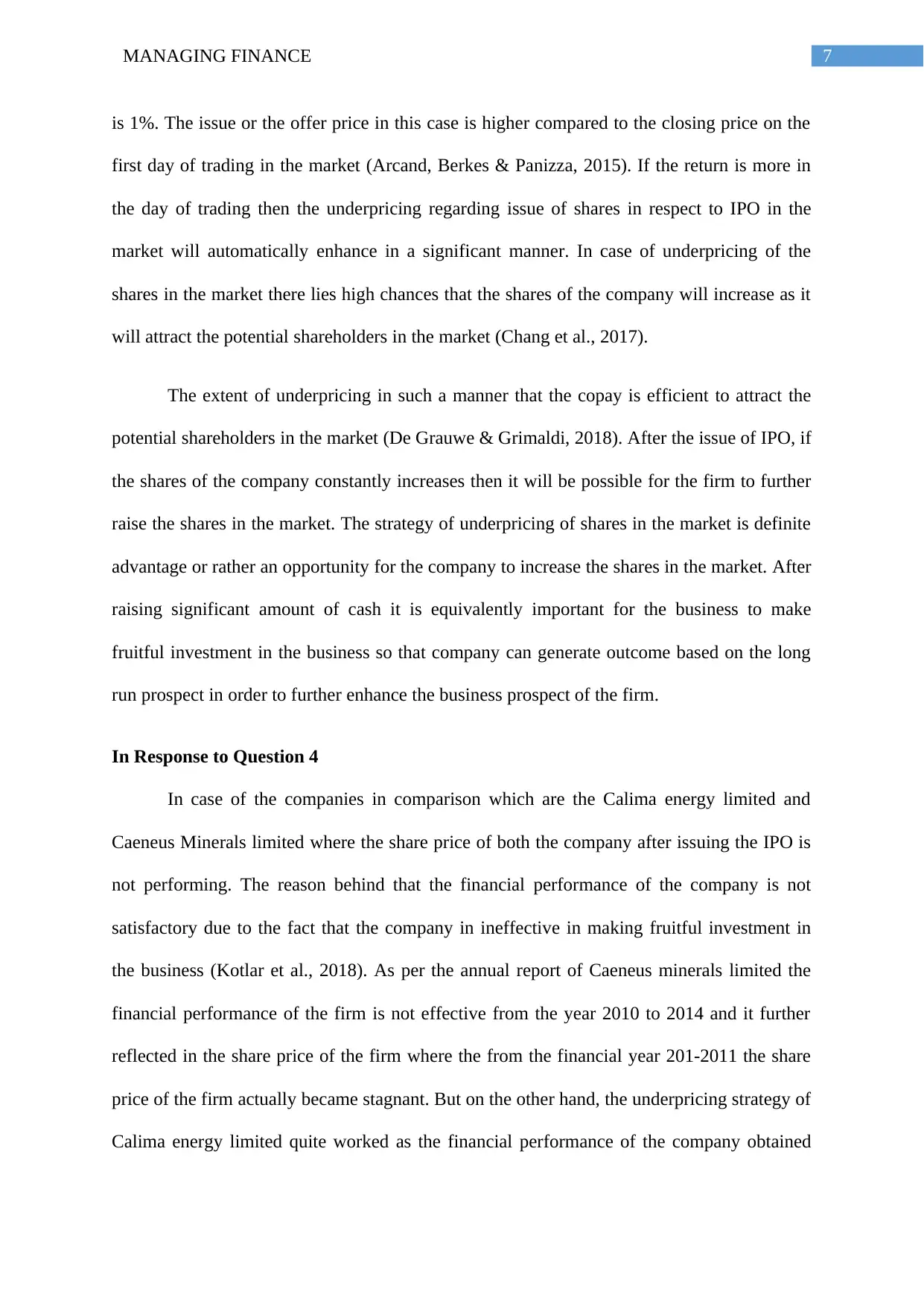
7MANAGING FINANCE
is 1%. The issue or the offer price in this case is higher compared to the closing price on the
first day of trading in the market (Arcand, Berkes & Panizza, 2015). If the return is more in
the day of trading then the underpricing regarding issue of shares in respect to IPO in the
market will automatically enhance in a significant manner. In case of underpricing of the
shares in the market there lies high chances that the shares of the company will increase as it
will attract the potential shareholders in the market (Chang et al., 2017).
The extent of underpricing in such a manner that the copay is efficient to attract the
potential shareholders in the market (De Grauwe & Grimaldi, 2018). After the issue of IPO, if
the shares of the company constantly increases then it will be possible for the firm to further
raise the shares in the market. The strategy of underpricing of shares in the market is definite
advantage or rather an opportunity for the company to increase the shares in the market. After
raising significant amount of cash it is equivalently important for the business to make
fruitful investment in the business so that company can generate outcome based on the long
run prospect in order to further enhance the business prospect of the firm.
In Response to Question 4
In case of the companies in comparison which are the Calima energy limited and
Caeneus Minerals limited where the share price of both the company after issuing the IPO is
not performing. The reason behind that the financial performance of the company is not
satisfactory due to the fact that the company in ineffective in making fruitful investment in
the business (Kotlar et al., 2018). As per the annual report of Caeneus minerals limited the
financial performance of the firm is not effective from the year 2010 to 2014 and it further
reflected in the share price of the firm where the from the financial year 201-2011 the share
price of the firm actually became stagnant. But on the other hand, the underpricing strategy of
Calima energy limited quite worked as the financial performance of the company obtained
is 1%. The issue or the offer price in this case is higher compared to the closing price on the
first day of trading in the market (Arcand, Berkes & Panizza, 2015). If the return is more in
the day of trading then the underpricing regarding issue of shares in respect to IPO in the
market will automatically enhance in a significant manner. In case of underpricing of the
shares in the market there lies high chances that the shares of the company will increase as it
will attract the potential shareholders in the market (Chang et al., 2017).
The extent of underpricing in such a manner that the copay is efficient to attract the
potential shareholders in the market (De Grauwe & Grimaldi, 2018). After the issue of IPO, if
the shares of the company constantly increases then it will be possible for the firm to further
raise the shares in the market. The strategy of underpricing of shares in the market is definite
advantage or rather an opportunity for the company to increase the shares in the market. After
raising significant amount of cash it is equivalently important for the business to make
fruitful investment in the business so that company can generate outcome based on the long
run prospect in order to further enhance the business prospect of the firm.
In Response to Question 4
In case of the companies in comparison which are the Calima energy limited and
Caeneus Minerals limited where the share price of both the company after issuing the IPO is
not performing. The reason behind that the financial performance of the company is not
satisfactory due to the fact that the company in ineffective in making fruitful investment in
the business (Kotlar et al., 2018). As per the annual report of Caeneus minerals limited the
financial performance of the firm is not effective from the year 2010 to 2014 and it further
reflected in the share price of the firm where the from the financial year 201-2011 the share
price of the firm actually became stagnant. But on the other hand, the underpricing strategy of
Calima energy limited quite worked as the financial performance of the company obtained
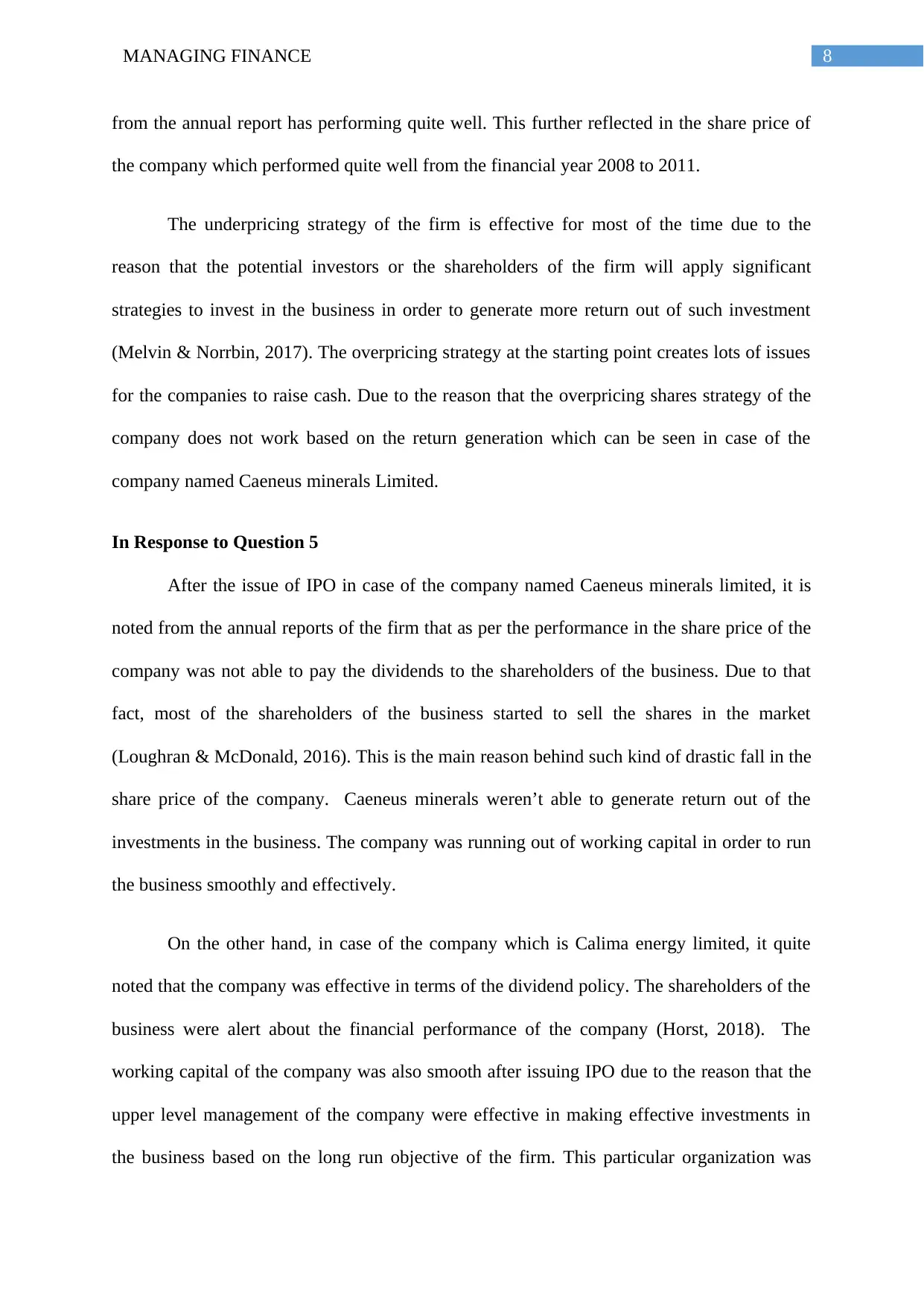
8MANAGING FINANCE
from the annual report has performing quite well. This further reflected in the share price of
the company which performed quite well from the financial year 2008 to 2011.
The underpricing strategy of the firm is effective for most of the time due to the
reason that the potential investors or the shareholders of the firm will apply significant
strategies to invest in the business in order to generate more return out of such investment
(Melvin & Norrbin, 2017). The overpricing strategy at the starting point creates lots of issues
for the companies to raise cash. Due to the reason that the overpricing shares strategy of the
company does not work based on the return generation which can be seen in case of the
company named Caeneus minerals Limited.
In Response to Question 5
After the issue of IPO in case of the company named Caeneus minerals limited, it is
noted from the annual reports of the firm that as per the performance in the share price of the
company was not able to pay the dividends to the shareholders of the business. Due to that
fact, most of the shareholders of the business started to sell the shares in the market
(Loughran & McDonald, 2016). This is the main reason behind such kind of drastic fall in the
share price of the company. Caeneus minerals weren’t able to generate return out of the
investments in the business. The company was running out of working capital in order to run
the business smoothly and effectively.
On the other hand, in case of the company which is Calima energy limited, it quite
noted that the company was effective in terms of the dividend policy. The shareholders of the
business were alert about the financial performance of the company (Horst, 2018). The
working capital of the company was also smooth after issuing IPO due to the reason that the
upper level management of the company were effective in making effective investments in
the business based on the long run objective of the firm. This particular organization was
from the annual report has performing quite well. This further reflected in the share price of
the company which performed quite well from the financial year 2008 to 2011.
The underpricing strategy of the firm is effective for most of the time due to the
reason that the potential investors or the shareholders of the firm will apply significant
strategies to invest in the business in order to generate more return out of such investment
(Melvin & Norrbin, 2017). The overpricing strategy at the starting point creates lots of issues
for the companies to raise cash. Due to the reason that the overpricing shares strategy of the
company does not work based on the return generation which can be seen in case of the
company named Caeneus minerals Limited.
In Response to Question 5
After the issue of IPO in case of the company named Caeneus minerals limited, it is
noted from the annual reports of the firm that as per the performance in the share price of the
company was not able to pay the dividends to the shareholders of the business. Due to that
fact, most of the shareholders of the business started to sell the shares in the market
(Loughran & McDonald, 2016). This is the main reason behind such kind of drastic fall in the
share price of the company. Caeneus minerals weren’t able to generate return out of the
investments in the business. The company was running out of working capital in order to run
the business smoothly and effectively.
On the other hand, in case of the company which is Calima energy limited, it quite
noted that the company was effective in terms of the dividend policy. The shareholders of the
business were alert about the financial performance of the company (Horst, 2018). The
working capital of the company was also smooth after issuing IPO due to the reason that the
upper level management of the company were effective in making effective investments in
the business based on the long run objective of the firm. This particular organization was
⊘ This is a preview!⊘
Do you want full access?
Subscribe today to unlock all pages.

Trusted by 1+ million students worldwide
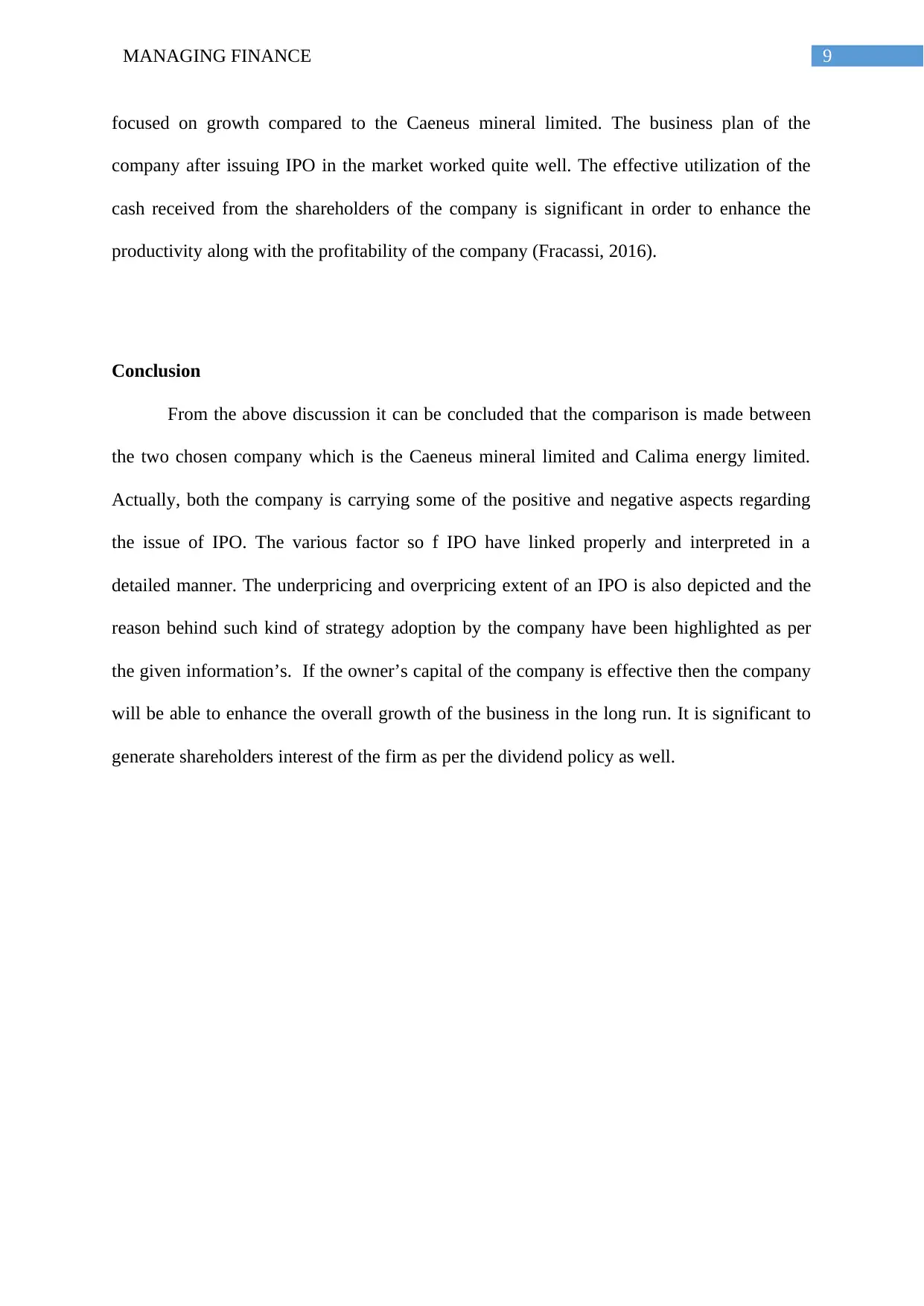
9MANAGING FINANCE
focused on growth compared to the Caeneus mineral limited. The business plan of the
company after issuing IPO in the market worked quite well. The effective utilization of the
cash received from the shareholders of the company is significant in order to enhance the
productivity along with the profitability of the company (Fracassi, 2016).
Conclusion
From the above discussion it can be concluded that the comparison is made between
the two chosen company which is the Caeneus mineral limited and Calima energy limited.
Actually, both the company is carrying some of the positive and negative aspects regarding
the issue of IPO. The various factor so f IPO have linked properly and interpreted in a
detailed manner. The underpricing and overpricing extent of an IPO is also depicted and the
reason behind such kind of strategy adoption by the company have been highlighted as per
the given information’s. If the owner’s capital of the company is effective then the company
will be able to enhance the overall growth of the business in the long run. It is significant to
generate shareholders interest of the firm as per the dividend policy as well.
focused on growth compared to the Caeneus mineral limited. The business plan of the
company after issuing IPO in the market worked quite well. The effective utilization of the
cash received from the shareholders of the company is significant in order to enhance the
productivity along with the profitability of the company (Fracassi, 2016).
Conclusion
From the above discussion it can be concluded that the comparison is made between
the two chosen company which is the Caeneus mineral limited and Calima energy limited.
Actually, both the company is carrying some of the positive and negative aspects regarding
the issue of IPO. The various factor so f IPO have linked properly and interpreted in a
detailed manner. The underpricing and overpricing extent of an IPO is also depicted and the
reason behind such kind of strategy adoption by the company have been highlighted as per
the given information’s. If the owner’s capital of the company is effective then the company
will be able to enhance the overall growth of the business in the long run. It is significant to
generate shareholders interest of the firm as per the dividend policy as well.
Paraphrase This Document
Need a fresh take? Get an instant paraphrase of this document with our AI Paraphraser
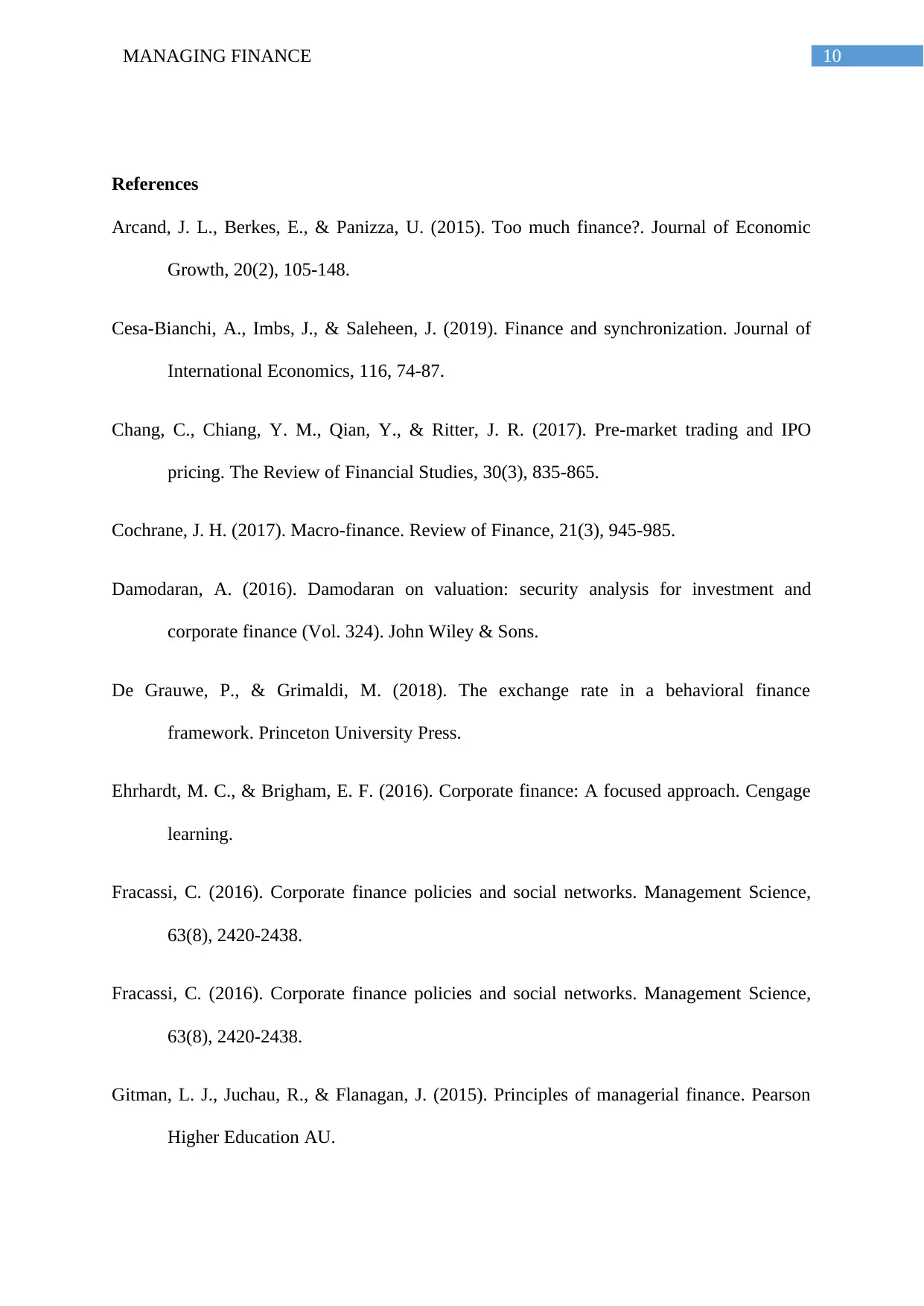
10MANAGING FINANCE
References
Arcand, J. L., Berkes, E., & Panizza, U. (2015). Too much finance?. Journal of Economic
Growth, 20(2), 105-148.
Cesa-Bianchi, A., Imbs, J., & Saleheen, J. (2019). Finance and synchronization. Journal of
International Economics, 116, 74-87.
Chang, C., Chiang, Y. M., Qian, Y., & Ritter, J. R. (2017). Pre-market trading and IPO
pricing. The Review of Financial Studies, 30(3), 835-865.
Cochrane, J. H. (2017). Macro-finance. Review of Finance, 21(3), 945-985.
Damodaran, A. (2016). Damodaran on valuation: security analysis for investment and
corporate finance (Vol. 324). John Wiley & Sons.
De Grauwe, P., & Grimaldi, M. (2018). The exchange rate in a behavioral finance
framework. Princeton University Press.
Ehrhardt, M. C., & Brigham, E. F. (2016). Corporate finance: A focused approach. Cengage
learning.
Fracassi, C. (2016). Corporate finance policies and social networks. Management Science,
63(8), 2420-2438.
Fracassi, C. (2016). Corporate finance policies and social networks. Management Science,
63(8), 2420-2438.
Gitman, L. J., Juchau, R., & Flanagan, J. (2015). Principles of managerial finance. Pearson
Higher Education AU.
References
Arcand, J. L., Berkes, E., & Panizza, U. (2015). Too much finance?. Journal of Economic
Growth, 20(2), 105-148.
Cesa-Bianchi, A., Imbs, J., & Saleheen, J. (2019). Finance and synchronization. Journal of
International Economics, 116, 74-87.
Chang, C., Chiang, Y. M., Qian, Y., & Ritter, J. R. (2017). Pre-market trading and IPO
pricing. The Review of Financial Studies, 30(3), 835-865.
Cochrane, J. H. (2017). Macro-finance. Review of Finance, 21(3), 945-985.
Damodaran, A. (2016). Damodaran on valuation: security analysis for investment and
corporate finance (Vol. 324). John Wiley & Sons.
De Grauwe, P., & Grimaldi, M. (2018). The exchange rate in a behavioral finance
framework. Princeton University Press.
Ehrhardt, M. C., & Brigham, E. F. (2016). Corporate finance: A focused approach. Cengage
learning.
Fracassi, C. (2016). Corporate finance policies and social networks. Management Science,
63(8), 2420-2438.
Fracassi, C. (2016). Corporate finance policies and social networks. Management Science,
63(8), 2420-2438.
Gitman, L. J., Juchau, R., & Flanagan, J. (2015). Principles of managerial finance. Pearson
Higher Education AU.
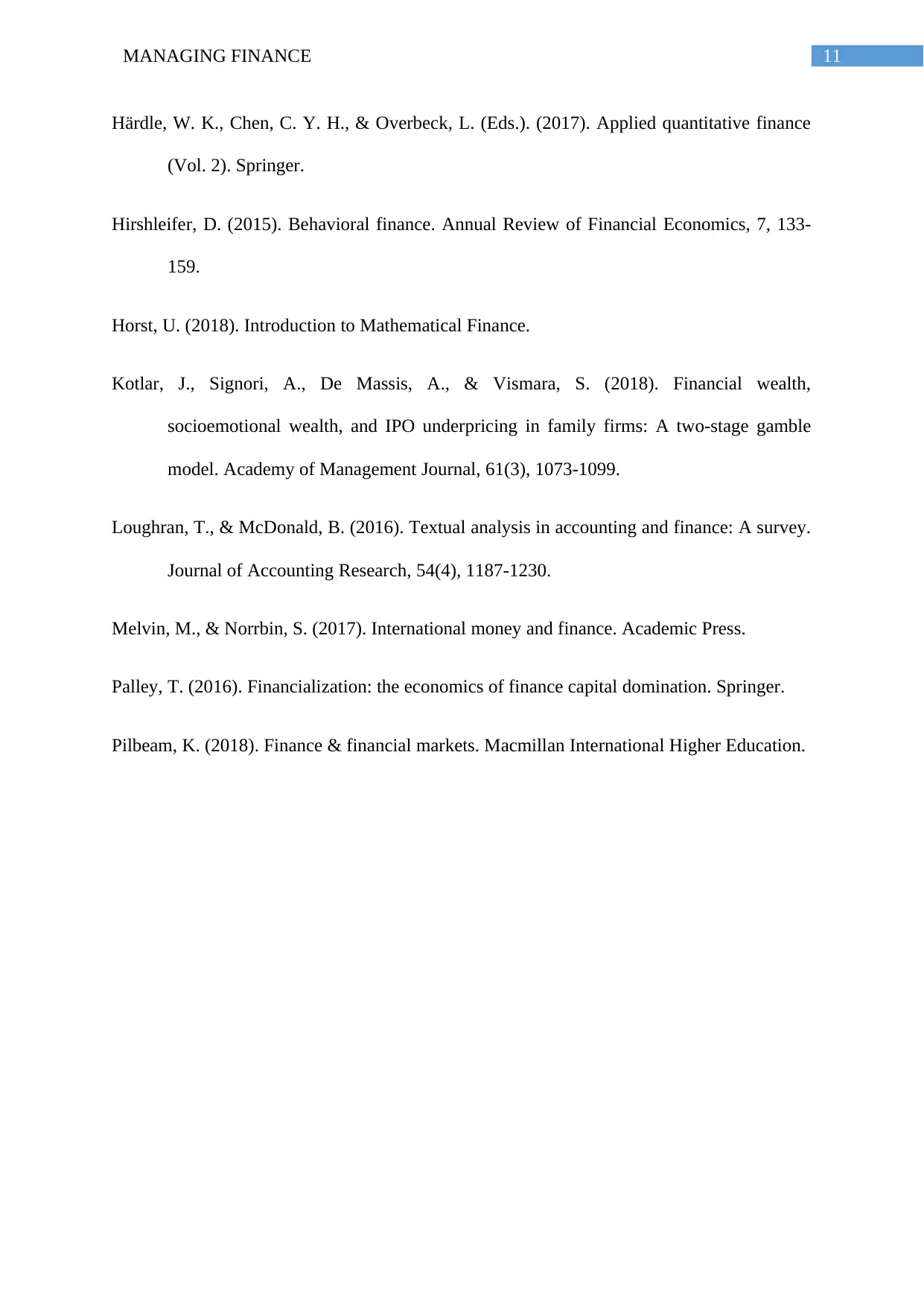
11MANAGING FINANCE
Härdle, W. K., Chen, C. Y. H., & Overbeck, L. (Eds.). (2017). Applied quantitative finance
(Vol. 2). Springer.
Hirshleifer, D. (2015). Behavioral finance. Annual Review of Financial Economics, 7, 133-
159.
Horst, U. (2018). Introduction to Mathematical Finance.
Kotlar, J., Signori, A., De Massis, A., & Vismara, S. (2018). Financial wealth,
socioemotional wealth, and IPO underpricing in family firms: A two-stage gamble
model. Academy of Management Journal, 61(3), 1073-1099.
Loughran, T., & McDonald, B. (2016). Textual analysis in accounting and finance: A survey.
Journal of Accounting Research, 54(4), 1187-1230.
Melvin, M., & Norrbin, S. (2017). International money and finance. Academic Press.
Palley, T. (2016). Financialization: the economics of finance capital domination. Springer.
Pilbeam, K. (2018). Finance & financial markets. Macmillan International Higher Education.
Härdle, W. K., Chen, C. Y. H., & Overbeck, L. (Eds.). (2017). Applied quantitative finance
(Vol. 2). Springer.
Hirshleifer, D. (2015). Behavioral finance. Annual Review of Financial Economics, 7, 133-
159.
Horst, U. (2018). Introduction to Mathematical Finance.
Kotlar, J., Signori, A., De Massis, A., & Vismara, S. (2018). Financial wealth,
socioemotional wealth, and IPO underpricing in family firms: A two-stage gamble
model. Academy of Management Journal, 61(3), 1073-1099.
Loughran, T., & McDonald, B. (2016). Textual analysis in accounting and finance: A survey.
Journal of Accounting Research, 54(4), 1187-1230.
Melvin, M., & Norrbin, S. (2017). International money and finance. Academic Press.
Palley, T. (2016). Financialization: the economics of finance capital domination. Springer.
Pilbeam, K. (2018). Finance & financial markets. Macmillan International Higher Education.
⊘ This is a preview!⊘
Do you want full access?
Subscribe today to unlock all pages.

Trusted by 1+ million students worldwide
1 out of 12
Related Documents
Your All-in-One AI-Powered Toolkit for Academic Success.
+13062052269
info@desklib.com
Available 24*7 on WhatsApp / Email
![[object Object]](/_next/static/media/star-bottom.7253800d.svg)
Unlock your academic potential
Copyright © 2020–2025 A2Z Services. All Rights Reserved. Developed and managed by ZUCOL.





